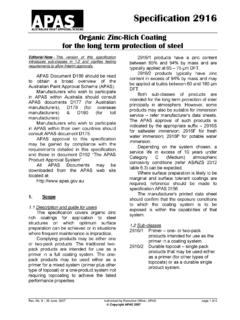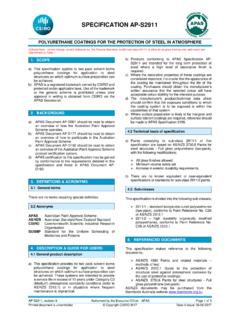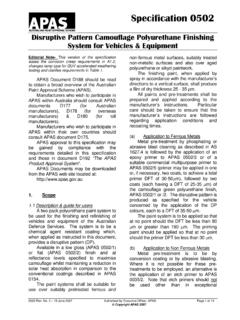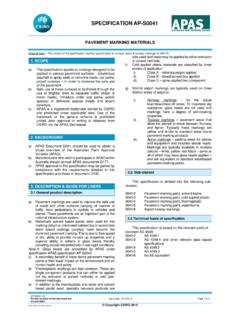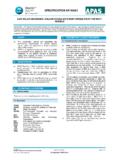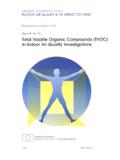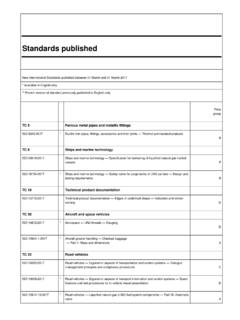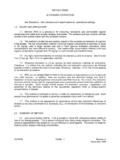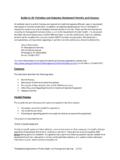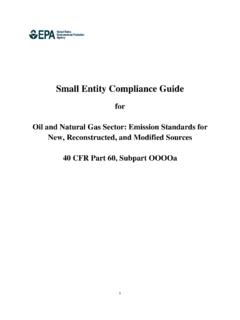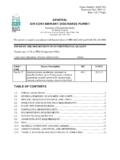Transcription of AP-D181 VOLATILE ORGANIC COMPOUNDS (VOC) …
1 AP-D181 VOLATILE ORGANIC COMPOUNDS (VOC) LIMITS AP-D181 , revision 11 Authorised by the Executive Officer - APAS Page 1 of 4 Printed document is uncontrolled Copyright CSIRO 2017 Date of issue: 26-10-2017 Editorial Note: This version adds the new APAS logo, editorial changes. THERE ARE NO CHANGES TO THE VOC DEFINITION, NOR THE VOC LEVELS, NOR THE DETERMINATION OF VOC CONTENT, NOR THE VOC LIMITS 1 SCOPE a) This document details the limits on VOLATILE ORGANIC COMPOUNDS (VOC), which will apply for the range of APAS paint specifications noted in Table 1 and Table 2 of this document, for the interval 2015 - 2019. b) APAS is a registered trademark owned by CSIRO and protected under applicable laws.
2 Use of the trademark or the general scheme is prohibited unless prior approval in writing is obtained from CSIRO via the APAS Secretariat. 2 AUTHORITY & RESPONSIBILITY The Executive Officer (EO) - APAS is responsible for the content of this document and for ensuring conformance to the noted VOC limits for product submission(s) and product re-submission(s) seeking certification to an APAS specification(s) listed in Table 1 and Table 2. 3 REFERENCED DOCUMENTS APAS Document AP-D001 should be read to obtain an overview of how the Australian Paint Approval Scheme operates. APAS Document AP-D004 should be read to obtain an overview of how to appeal a decision made by APAS and/or lodge a complaint against an APAS officer.
3 APAS Document AP-D139 Application form for product certification. APAS Document AP-D177 should be read to obtain an overview of how to participate in the Australian Paint Approval Scheme. APAS Document AP-D182 Statement of VOLATILE ORGANIC compound (VOC) Content in paint. APAS Document AP-D192 should be read to obtain an overview of the Australian Paint Approval Scheme product certification system. ASTM D2369 Standard Test Method for VOLATILE Content of Coatings. ASTM D3960 Standard Practice for Determining VOLATILE ORGANIC compound (VOC) Content of Paints & Related Coatings. 4 DEFINITIONS & ACRONYMS General terms VOC VOLATILE ORGANIC COMPOUNDS present in paint formulations (either as a unique ingredient or as a component of an ingredient/manufactured intermediate) that has; a) a vapour pressure > Hg at 21 C or, b) an initial boiling point <250 C measured at a standard pressure of kPa.
4 Note 1: Ammonia will be classified as a VOC Note 2: Acetone is not considered a VOC as current evidence indicates it does not participate in smog forming reactions. VOC Levels The following descriptors have been adopted by APAS; Very High > 250 g/L High 100 249 g/L Moderate 50 99 g/L Low 5 49 g/L Very Low < 5 g/L Acronyms APAS Australian Paint Approval Scheme APMF Australian Paint Manufacturers Federation CSIRO Commonwealth Scientific and Industrial Research Organisation CVS CSIRO Verification Services EO Executive Officer - APAS g/L grams per litre 5 BACKGROUND Technical a) VOCs contribute negatively to air pollution by participating in the chemical reactions that take place in the atmosphere and produce a variety of air pollution effects including the effect known as "smog".
5 B) The Guide to VOC Reduction in Decorative Coatings produced by the CEPE (European Industrial Council for Paints, Printing Inks and Artists Colours) Technical Committee Decorative Paints states: The action of sunlight on NOx and VOCs leads to the formation of ground level ozone, a long-range pollutant, which can impact on rural areas at some distance from the original source of emission. Ozone can irritate the eyes and lungs, causing breathing difficulties, and may reduce resistance to infection. Ozone can also damage some vegetation, crops and trees. Ozone levels are normally higher on still, sunny, summer days, when the air is already polluted with NOx and VOCs ( urban areas with traffic).
6 Because of the time required for the chemical reactions to take place, ozone formation tends to occur downwind of the pollution. The resulting smog may persist for several days and can be transported over long distances . AP-D181 VOLATILE ORGANIC COMPOUNDS (VOC) LIMITS AP-D181 , revision 11 Authorised by the Executive Officer - APAS Page 2 of 4 Printed document is uncontrolled Copyright CSIRO 2017 Date of issue: 26-10-2017 c) VOCs also contribute negatively to indoor air quality through emissions, both during and after curing, into the daily living environment. As a result, they impact on individual health and well-being including personal allergic reactions.
7 This aspect of VOCs is not the subject of this document. Historical a) Since 1996, APAS has been setting limits for VOC content of certified products. Progressive reductions have been made over this period and this version of the document details the latest round of reductions which have been arrived at in consultation with the APMF. b) The limits set in this document apply only to APAS certified paints sold in Australia and New Zealand. 6 DETERMINATION OF VOC CONTENT The VOC content of a paint or coating shall be determined by one or more of the following methods; a) Determined by calculation using the suppliers raw material data.
8 Applying the definition of a VOC as noted in Clause , determine the VOC content for every raw material/intermediate in the formulation. Tally the VOC content of every raw material/intermediate in the formulation to determine the to tal VOC content of the formulation or, b) Determined experimentally in accordance with ASTM D3960 as qualified below: By determining the weight percent non- VOLATILE content (and hence the VOLATILE content) by ASTM D2369 (60 minutes at 110 5 C) and converting to g/L (as per ASTM D3960). This method is inappropriate for constituents that decompose at elevated temperature. Note 3: Where the supplier fails to report VOC content for the ingredient in accordance with the above definition, or where the intermediate formula is not known, the VOC content must be determined as per Clause b).
9 Note 4: The VOC shall be expressed to include any thinning solvent recommended as mandatory on the label or data sheet for the method of application proposed. Note 5: Tinter additions are excluded from VOC calculations. 7 REPORTING OF RESULTS a) For initial product certification applications or a full re-submissions, notification of the VOLATILE ORGANIC compound (VOC) Content shall be reported on APAS Document AP-D182. b) For minor re-submissions, where there has been no significant change to the formulation, notification of the VOLATILE ORGANIC compound (VOC) Content shall be reported on APAS Document AP-D139. 8 ARCHITECTURAL COATINGS a) Table 1 of this document lists the APAS specifications for architectural coatings where a VOC limit applies.
10 B) In order to allow greater formulating flexibility, where organisations that manufacture architectural coatings of the type(s) noted in Table 1 have a number of products ( tinting bases) certified to the one APAS specification, APAS allows the use of average and maximum VOC limits. This allows paint formulators greater flexibility in formulating paints that require higher VOC content to make them easier to apply. These paints (typically deep and ultra deep-style tint bases) are significantly lower in sales volume compared to whites and light tint bases and so, have less of an impact on the environment. c) Where an organisation has more than one architectural product certified against an APAS specification listed in Table 1, the average VOC shall be calculated.
